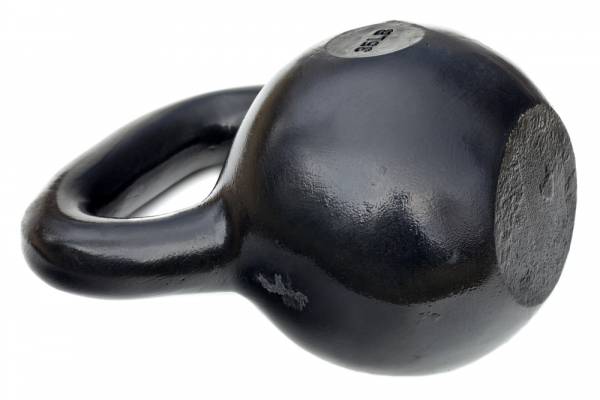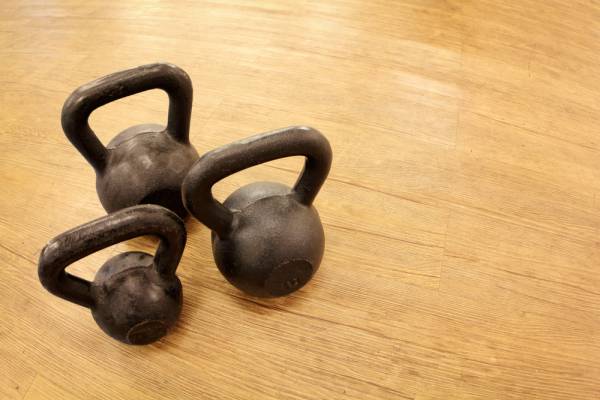Imagine I offered to pay you 25% more for the same job you’re doing right now? Do you think that would make a noticeable difference in your life? But that’s probably not a likely scenario, right? The way life usually works is that if you want 25% more pay, then you’re going to have to work at least 25% harder. And that’s the way it is with kettlebells, too.
Early on bells only came in three sizes: the one pood (16kg/35lbs), one-and-a-half pood (24kg/54lbs), and the two pood (32kg/72lbs). Yeah, I said pood. It still makes me giggle.
Then as we Westernized kettlebells, we added different sizes like the 12kg and 8kg so that women would be able to use them. Slowly, we’ve added more and more sizes to bridge the gaps in between bells. Because the thing with those 4kg jumps is that even though it’s “just” 4kg, it can feel like a lot more. That’s because when you go from a 12kg to a 16kg – just 4kg, remember – it’s a jump of 30%. And to go from 16kg to 24kg (which used to be the only option) is a jump of 50%.
When was the last time you did squats and were able to use 50% more on the next workout? And that’s exactly why companies have worked to create in-between bells to fill those gaps.
One of the things I liked when I found kettlebells was the patience required to go from bell size to bell size. Because I started using them to rehabilitate my shoulder, I spent a lot of time with a 16kg at the beginning. In fact, I didn’t own anything smaller, and my only other bell was a 24kg. The shoulder problem was too bad to rehab and I ultimately ended up needing surgery, but returned again to my 16kg once I was cleared to lift weights.
To be honest, once my shoulder was healthy I made the jump to the 24kg pretty quickly. And from there I handled most training with it pretty easily until I felt ready for the 32kg. As anyone who has done it before will tell you, everything is actually pretty smooth sailing and you can progress quickly until you hit 32kg, and then it gets tough.
And this is where good programming comes in.
Let’s say you’ve gone from a bell you can press five times to a bell you can only press once or twice. This is common when women jump from the 12kg to the 16kg – that 30% jump. In most kettlebell programs for pressing, the advice is that you’d do a series of ladders split over three days to get stronger. However, this plan doesn’t really take into account that when you go up a bell you may have only just gone up a bell.
The real problems with this program are that on two of the days per week volume is dropped so your heavy day is really the high-volume day, and the medium and light days are really medium- and light-volume days. In other words, the expressions have nothing to do with intensity, which can be misleading given they involve words like heavy and light.
 There are only three things you can really change in a program. You can lift more weight (intensity), lift it more times (volume) or lift it the same number of times as previously but in a shorter time frame (density). Because kettlebells have these big jumps in load you’re actually better off manipulating volume or density than you are intensity.
There are only three things you can really change in a program. You can lift more weight (intensity), lift it more times (volume) or lift it the same number of times as previously but in a shorter time frame (density). Because kettlebells have these big jumps in load you’re actually better off manipulating volume or density than you are intensity.
Volume Strategy
The following plan is by my friend and former Master RKC and brainiac Kenneth Jay.
I’m a big believer that you will still need to use the bell you’re struggling with on one day per week, so that you get used to the weight. On this day, all you’re going to do is 10 sets of 1-2 reps. In intensity terms this is actually a pretty tough day as doing ten nearly all out singles per hand is quite tough.
However, it’s nowhere near as tough as the high-volume day. On this day build up to doing 20 sets of 5 with the lower bell. I like to start at 10 sets of 3 and work my way up. Here’s how the progression works:
- Week 1: 10 sets of 3
- Week 2: 10 sets of 4
- Week 3: 10 sets of 5
- Week 4: 15 sets of 5
- Week 5: 20 sets of 5
If it doesn’t work out exactly like that, and it may not, just keep working at whatever level you’re at until you finish the plan, before moving on. I’ve used this with great success in the past with the women I’ve trained for the Iron Maiden (24kg press, pull up, and pistol) and it just works. If you’ve got the time and patience, adding training volume will always work.
Density Strategy
For people who have never heard of Escalating Density Training (EDT), I suggest getting out from under your rock and reading Charles Staley’s work. EDT is a fantastic way to train that just makes sense, and much of today’s current fitness trend in working “every minute on the minute” is a form of EDT.
The basic principle is that you perform as many reps as you can in a given time frame. Let’s use the previous example of 20 sets of 5 and say it took us forty minutes to achieve our 100 reps. Typically you’d look to reduce the target time by 10% before adding weight and beginning the process again. But the pesky weight jumps with kettlebells make this an unwieldy strategy. The best bet is to just whittle it down as far as you can, without trying to be ridiculous about it.
Combined Strategy
This approach is similar to what Pavel recommends in “Return of the Kettlebell.”
This is what the really smart people will do – combine both methods. If you’ve got a bell you can press for a few sets of five, but no more, then you can combine both concepts. Let’s say you can get 5 sets of 5 and it takes you 10 minutes. Here’s how it might progress:
- Week 1: 5 x 5 in 10 minutes
- Week 2: 5 x 5 in 9 minutes 30 seconds
- Week 3: 5 x 5 in 8 minutes 30 seconds
- Week 4: 5 x 5 in 8 minutes
 At this point you’ve already improved performance by 20%, and the best bet now is to add volume. You may be able to bring that time down further, but the goal is increasing strength, not turning this into a conditioning bout. So now start with 10 sets of 5, with no time limit, and repeat the whole process over again until you can no longer reduce the time appreciably. At that point, increase the total sets to 12 to 15 and begin again. Don’t forget that one day per week you’re still going to be pressing that heavy bell for 10 sets of 1-2 reps, although I will bet it won’t be feeling so heavy by now.
At this point you’ve already improved performance by 20%, and the best bet now is to add volume. You may be able to bring that time down further, but the goal is increasing strength, not turning this into a conditioning bout. So now start with 10 sets of 5, with no time limit, and repeat the whole process over again until you can no longer reduce the time appreciably. At that point, increase the total sets to 12 to 15 and begin again. Don’t forget that one day per week you’re still going to be pressing that heavy bell for 10 sets of 1-2 reps, although I will bet it won’t be feeling so heavy by now.
You’ll find you can follow this program for an almost indefinite period of time, and it naturally allows for easy and hard weeks in order to prevent burn out. The best thing about taking your time on each bell is that you will build form as you go. As they get bigger and bigger, each new bell adds considerable torque at the shoulder and developing the stability to press safely will take a lot of time. Be patient with the jumps and think of each bell as a new belt in a martial arts that needs to be learned about and grown into, rather than as a step to get past as quickly as possible.
Photos courtesy of Shutterstock.






